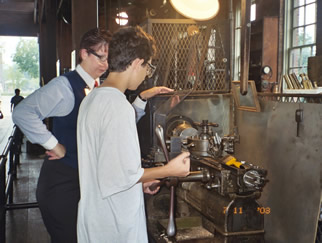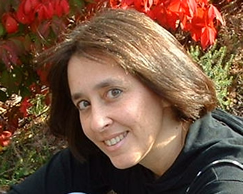Greenfield Village: Henry Ford’s Celebration of Inventors and Machines
[Part 3 of my Manufacturing Travel Log (If you can't get enough, read Part 1 and Part 2. More to come!)]
Greenfield Village in Dearborn, MI was extremely interesting, both for what was there and for what it said about Henry Ford’s interests. Ford relocated buildings that represented important innovations of his day. These included Thomas Edison’s home, workshop, and early electrification station.
In addition, there was an operating railroad roundhouse where steam locomotives were still being repaired and serviced. (The roundhouse had some amazing machining tools, very large and used to make and repair parts for the trains. I was dying to go down to the floor and take a look, but the guide said he could not let me for safety reasons.) There was also an interesting display to explain how the burning coal was used to create steam, which then moved the pistons, which turned the wheel. I had never noticed the box at the end of the piston, where the steam actually came in and forced the piston to move. I still did not understand this fully—it seemed that the steam would have to be pulsed into the box so that the piston could move back into position between each stroke?
A Machinist is Born
 One of the highlights of Greenfield Village was the machine shop, where we had the chance to actually “cut metal” using a 1917 Brown and Sharpe turret lathe. Both my son and I took our turn to don safety glasses, and make a small brass candlestick. With apologies to “real” machinists, since I will not know the official terms for what we did, here is what I observed.
One of the highlights of Greenfield Village was the machine shop, where we had the chance to actually “cut metal” using a 1917 Brown and Sharpe turret lathe. Both my son and I took our turn to don safety glasses, and make a small brass candlestick. With apologies to “real” machinists, since I will not know the official terms for what we did, here is what I observed. The mechanism was fascinating and so well thought out: the cutting tools were brought to the rotating brass rod by a mechanism that was hand-turned. We turned the handwheel counter-clockwise to move the bits to the left, and clockwise to pull back when the cut was complete. At the extreme of the turn, the piece holding the various bits (I think this was the “turret”?) would rotate and click into place so that the next bit was in position. I think there were 6 different cutting steps—two were used to drill out the center hole of the candleholder (for the candle), two removed excess metal from the outside of the piece to save wear on the carbide cutter that actually produced the curved shape of the candlestick. A final cut was a blade that cut the finished candlestick from the brass stock. These last 2 cuts were made by turning a separate handwheel that moved the rotating brass “south” to the carbide shaping blade, and “north” to the blade that cut the finished product from the brass bar.
 It was a little tricky to keep the progress of the cutting tool at an even speed, and not too fast. The turned piece gets quite hot from the friction, but there was no coolant involved. The docent said that occasionally someone breaks a bit or gets the lathe out of alignment and they have to stop and call their historical machinist. (Now that would be a fun job for someone!)
It was a little tricky to keep the progress of the cutting tool at an even speed, and not too fast. The turned piece gets quite hot from the friction, but there was no coolant involved. The docent said that occasionally someone breaks a bit or gets the lathe out of alignment and they have to stop and call their historical machinist. (Now that would be a fun job for someone!) With one small project under my belt, I begin to see how people get hooked on cutting metal. Time to move the cars out of the garage, and start moving old metal in!
Stephanie, Webmaster
StillMadeinUSA.com


0 Comments:
Post a Comment
Links to this post:
Create a Link
<< Home